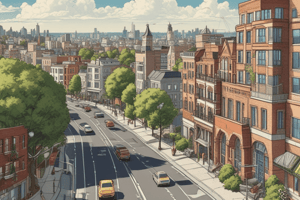Podcast
Questions and Answers
Prioritizing the needs and well-being of residents through participatory planning is encompassed by 'Community-Centered Design'.
Prioritizing the needs and well-being of residents through participatory planning is encompassed by 'Community-Centered Design'.
True (A)
'Land Use Efficiency' solely focuses on maximizing residential space, neglecting the importance of balancing it with commercial, industrial, and recreational areas.
'Land Use Efficiency' solely focuses on maximizing residential space, neglecting the importance of balancing it with commercial, industrial, and recreational areas.
False (B)
Public administrators' role in urban development strictly involves enforcing regulations, with no regard to promoting sustainable practices or economic growth.
Public administrators' role in urban development strictly involves enforcing regulations, with no regard to promoting sustainable practices or economic growth.
False (B)
Investing in transportation, utilities, and public services to accommodate a growing urban population is defined as 'Improving Infrastructure'.
Investing in transportation, utilities, and public services to accommodate a growing urban population is defined as 'Improving Infrastructure'.
Promoting eco-friendly urban planning, waste management, and renewable energy usage is referred to as 'Unsustainable Practices'.
Promoting eco-friendly urban planning, waste management, and renewable energy usage is referred to as 'Unsustainable Practices'.
Housing policies exclusively target mitigating urban sprawl, overlooking impacts related to equity and sustainability.
Housing policies exclusively target mitigating urban sprawl, overlooking impacts related to equity and sustainability.
Sustainable transportation's primary goal is to increase traffic congestion to foster a greater sense of community.
Sustainable transportation's primary goal is to increase traffic congestion to foster a greater sense of community.
Citizen participation in urban governance solely benefits the government by ensuring compliance, with limited impacts on community needs.
Citizen participation in urban governance solely benefits the government by ensuring compliance, with limited impacts on community needs.
The private sector's role in public-private collaborations is confined to providing financial resources, excluding any involvement in innovation or expertise.
The private sector's role in public-private collaborations is confined to providing financial resources, excluding any involvement in innovation or expertise.
Public-private partnerships consolidate all risks onto the public sector, simplifying project management and reducing bureaucratic processes.
Public-private partnerships consolidate all risks onto the public sector, simplifying project management and reducing bureaucratic processes.
Flashcards
Sustainability in Urban Planning
Sustainability in Urban Planning
Meeting current urban development needs without compromising future generations' ability to meet theirs, including environmental conservation and green spaces.
Community-Centered Design
Community-Centered Design
Prioritizing residents' needs and well-being through participatory planning, giving the community a voice in decisions.
Land Use Efficiency
Land Use Efficiency
Balancing residential, commercial, industrial, and recreational spaces to reduce urban sprawl and maximize land utility.
Connectivity and Accessibility
Connectivity and Accessibility
Signup and view all the flashcards
Urban Resilience
Urban Resilience
Signup and view all the flashcards
Aesthetic and Cultural Preservation
Aesthetic and Cultural Preservation
Signup and view all the flashcards
Urban Health and Safety
Urban Health and Safety
Signup and view all the flashcards
Economic Opportunities
Economic Opportunities
Signup and view all the flashcards
Community Engagement
Community Engagement
Signup and view all the flashcards
Improving Infrastructure
Improving Infrastructure
Signup and view all the flashcards
Study Notes
- Urban planning and management principles are guidelines and approaches used to design, develop, and maintain sustainable, functional, and efficient urban areas.
Key Principles of Urban Planning and Management
- Sustainability ensures urban development meets current needs without compromising future generations, including environmental conservation, green spaces, and sustainable infrastructure.
- Community-Centered Design prioritizes residents' needs through participatory planning, giving the community a voice in decisions.
- Land Use Efficiency involves utilizing land effectively by balancing residential, commercial, industrial, and recreational spaces to reduce urban sprawl and maximize utility.
- Connectivity and Accessibility focuses on creating efficient transportation networks to ensure accessibility to public spaces, connecting people with jobs, education, and healthcare.
- Resilience focuses on designing urban areas that can adapt and withstand challenges like natural disasters, climate change, or economic shifts.
- Aesthetic and Cultural Preservation involves incorporating architectural beauty and preserving cultural heritage to foster a sense of identity and pride.
- Economic Viability encourages economic growth and development while supporting local businesses and ensuring equitable opportunities.
- Health and Safety promotes a clean and healthy urban environment, reduces pollution, and ensures public safety.
Responsibilities of Public Administrators in Urban Development
- Policy Development and Implementation: Public administrators create and enforce policies that guide urban planning and development, including zoning laws, housing regulations, and environmental policies.
- Infrastructure Planning and Management: They oversee the development and maintenance of essential infrastructure such as transportation systems, utilities, schools, and healthcare facilities.
- Resource Allocation: Administrators are responsible for budgeting and distributing resources to various urban development projects, ensuring efficient and equitable use.
- Community Engagement: They work with communities to gather input and address concerns to align urban development with the needs and aspirations of residents.
- Regulation and Compliance: Public administrators enforce laws and standards related to construction, safety, and environmental protection to ensure urban development is safe, ethical, and sustainable.
- Promoting Economic Development: They attract investments, support local businesses, and create job opportunities to drive economic growth.
- Sustainability and Resilience: Administrators implement initiatives to promote sustainable practices, such as energy efficiency, waste management, and climate resilience.
- Crisis Management: They coordinate efforts to respond, recover, and rebuild urban areas effectively during emergencies or natural disasters.
Strategies for Urbanization in the Philippines
- Improving Infrastructure: Investing in transportation, utilities, and public services to accommodate the growing urban population and reduce congestion.
- Affordable Housing: Developing housing projects to address shortages and prevent the growth of informal settlements addressing concerns like overcrowding.
- Sustainable Practices: Promoting eco-friendly urban planning, waste management, and renewable energy to minimize environmental impact
- Economic Opportunities: Creating jobs and supporting local businesses to reduce unemployment and underemployment.
- Community Engagement: Involving residents in urban planning decisions to address their needs and concerns.
- Decentralization: Encouraging development in smaller cities and rural areas to reduce pressure on major urban centers like Metro Manila.
- Education and Awareness: Raising awareness about the benefits of sustainable urban living and providing education to empower communities.
Importance of Housing Policies and Programs
- Alleviating Housing Shortages: Solutions that meet the demand for affordable and adequate housing to reduce overcrowding
- Improving Quality of Life: Policies that offer safe, secure, and livable housing to enhance well-being, health, and overall living conditions.
- Promoting Social Inclusion: Housing programs that target vulnerable groups, including low-income families, to ensure equitable access to shelter and reduce social disparities.
- Stimulating Economic Growth: Construction and housing projects that create job opportunities and boost local economies, fostering development.
- Encouraging Urban Planning: Promote the development of organized, resilient, and sustainable cities, balancing residential areas with infrastructure and green spaces.
- Environmental Sustainability: Modern housing initiatives that incorporate eco-friendly practices, such as energy-efficient designs, help mitigate urban environmental challenges.
Significance of a Sustainable Urban Transportation System
- Reducing Environmental Impact: Minimizes greenhouse gas emissions, air pollution, and energy consumption, to contribute to a healthier planet.
- Improving Public Health: Reduces air and noise pollution to enhance the overall health and quality of life for urban residents.
- Enhancing Mobility and Accessibility: Sustainable systems, like efficient public transit and pedestrian-friendly infrastructure, ensure easy access to jobs, education, and healthcare, fostering inclusivity.
- Alleviating Traffic Congestion: Promoting alternatives to private vehicles, such as buses, trains, and bicycles, helps reduce traffic jams, saving time and improving urban productivity.
- Supporting Economic Development: Improved connectivity supports businesses, tourism, and commerce while creating jobs in transportation and infrastructure development.
- Encouraging Social Equity: Sustainable transportation systems are designed to be affordable and accessible, benefiting disadvantaged groups and reducing inequality.
- Building Resilient Cities: Prepares urban areas to adapt to challenges like population growth, climate change, and resource scarcity, to ensure long-term sustainability.
Importance of Citizen Participation in Urban Governance
- Promotes Democracy: Engages citizens to ensure transparency, accountability, and fairness in decision-making, strengthening democratic values.
- Addresses Community Needs: Provides valuable insights into local challenges and priorities, enabling more targeted and relevant policies.
- Fosters Community Ownership: Involves people in urban projects to encourage a sense of belonging and responsibility, leading to better maintenance of public spaces and resources.
- Encourages Innovation: Offers fresh perspectives and creative solutions to urban issues, enriching the planning process.
- Builds Trust: Open dialogue between governments and citizens enhances trust, cooperation, and mutual understanding.
- Improves Policy Effectiveness: Shapes policies through citizen input, making them more likely to be accepted, implemented, and successful.
- Reduces Inequalities: Ensures marginalized groups have a voice, promoting equity and inclusivity in urban development.
Importance of Public-Private Collaboration
- Resource Mobilization: Supplements public funding with private investment, enabling larger and more ambitious urban projects.
- Innovation and Expertise: The private sector brings technical expertise, innovation, and efficiency to urban planning and development.
- Risk Sharing: Distributes financial, operational, and managerial risks between the two sectors, reducing the burden on any single party.
- Improved Infrastructure: Leads to the development of high-quality infrastructure, such as transportation systems, utilities, and smart cities.
- Economic Growth: Attracts investments, creates jobs, and stimulates local economies.
- Community Benefits: Prioritizes public needs, such as affordable housing, education, and healthcare, utilizing private sector efficiency to deliver better services.
- Sustainability: Encourages environmentally responsible projects and green initiatives, such as renewable energy systems and eco-friendly urban designs.
- Unites resources and expertise to overcome urban challenges and drive progress.
Transformative Redevelopment in Bonifacio Global City
- Dedication to mixed-use development with residential areas near retail stores, offices, and recreational facilities
- Emphasizes walkability with pedestrian-friendly streets, wide sidewalks, and bike lanes.
- Inclusion of green spaces like Track 30th and the Bonifacio High Street Greenway.
- Smart city initiatives include smart parking systems, intelligent traffic management, and free Wi-Fi.
Hub of Innovation: Cebu IT Park
- Focuses on sustainability and technological advancement in Cebu City.
- Designed to encourage the use of renewable energy, promote energy efficiency, and reduce environmental impacts with the addition of solar panels.
- Emphasizes green spaces and pedestrian-friendly infrastructure with wide paths, bike lanes, and landscaped gardens that create a welcoming environment.
- Includes smart technology to make operations smoother, such as traffic management systems and smart lighting systems.
Lessons Learned
- Adaptability is crucial for ensuring that urban areas remain relevant and vibrant.
- Public-private partnerships allow the government to leverage the expertise and resources of the private sector.
- Important elements in the evolution of urban planning include mixed-use zoning and promotion of sustainable practices.
- Essential to use a human-centered design philosophy to encourage social connections and overall quality of life.
Role of Technology in Future Urban Planning
- Technology will play an increasingly important role in future urban planning.
- Smart city technologies can help to improve efficiency, sustainability, and quality of life.
- Data collected from smart sensors can be used to make better decisions about urban planning and resource management.
Conclusion: A Path Forward
- Innovative urban planning focuses on integrated development, sustainability, and community involvement.
- Urban planners must continue to work to create environments that are not just functional but also improve the lives of their residents.
- By embracing innovation, sustainability, and community engagement, we can create cities that are more livable, resilient, and equitable for all.
Studying That Suits You
Use AI to generate personalized quizzes and flashcards to suit your learning preferences.





